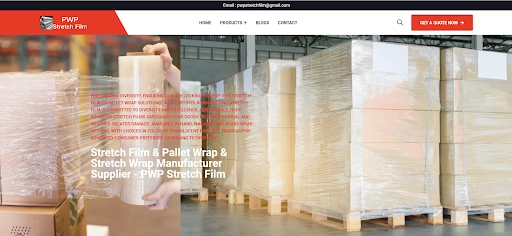When using hand stretch film, the goal is to ensure your packaging process is as efficient and cost-effective as possible while maintaining the integrity of your goods. Proper application, storage, and disposal techniques not only reduce material waste but also improve security during transit. PWP Stretch Film, a reliable supplier, offers hand stretch films that are designed to enhance efficiency and reduce waste. Below are some practical tips to help you get the most out of your hand stretch film.
Proper Application
Proper application of hand stretch film is crucial to ensure maximum performance and prevent unnecessary waste. Here are a few tips to ensure correct application:
- Stretch the Film Properly:
One of the most important aspects of hand stretch film application is achieving the correct stretch ratio. Over-stretching the film weakens its structure, while under-stretching results in insufficient load containment. Typically, stretch films have a recommended stretch ratio (e.g., 200% or 300%), meaning the film can be stretched to 2 to 3 times its original length without losing its strength. Adjusting the stretch ratio based on the product being wrapped helps to maximize the amount of film used and minimizes material waste.
For machine stretch film, this is even more critical as automated systems rely on precise stretch ratios to maintain consistent application. Automated wrapping with machine stretch film often requires a higher stretch ratio to maximize the stretchable length of the film and ensure fewer film changes. This is especially true for bulkier items or when wrapping large volumes of products.
- Maintain Consistency in Wrapping:
For consistent load stability, apply the film evenly across the load. This is particularly important when wrapping irregularly shaped products, which may require a more precise application. A stable wrap ensures that the load is securely contained and prevents shifting during transit, reducing the risk of product damage. - Overlap the Film for Better Containment:
Overlapping the film during wrapping is essential to ensure it sticks to itself and holds the load tightly in place. A 50-75% overlap is recommended for optimal cling and containment. Proper overlap not only strengthens the bond but also prevents the film from slipping off, especially for heavier or bulkier loads. - Consider Film Type for Specific Needs:
For businesses that deal with sensitive or metal goods, consider using VCI stretch film. VCI (Vapor Corrosion Inhibitor) stretch film is specially designed to protect metal products from rust and corrosion. If you’re packaging metal parts or machinery for long-term storage or international shipping, VCI stretch film offers additional protection alongside the standard benefits of load containment and stretchability.
Storage
To maintain the quality of your stretch film and ensure its longevity, it’s important to store it correctly:
- Store in a Cool, Dry Location:
Stretch film should be kept in a dry, cool environment to preserve its flexibility and stretchability. Extreme heat or humidity can cause the film to degrade, becoming brittle and less effective. Ideally, the storage area should be free from direct sunlight, which can also damage the film’s structure over time. - Proper Roll Orientation:
Store the rolls vertically rather than stacking them horizontally under heavy loads. This prevents any unnecessary pressure on the film, which could distort its shape or make it harder to unroll evenly when it’s time to use it. Keeping the rolls upright also ensures that the film unrolls smoothly without tangles or kinks. - Avoid Excessive Weight or Pressure:
Do not place heavy objects on top of stored film rolls, as this can cause deformation, making it more difficult to apply and decreasing its overall effectiveness.
Environmental Considerations
Proper disposal and recycling of stretch film are essential for minimizing its environmental impact. Here are some ways to handle stretch film responsibly:
- Recycling:
Stretch film is recyclable, but not all recycling centers accept it in regular recycling bins. Always check with your local recycling facilities to see if they accept plastic film. Some centers have specialized bins for plastic film, while others may require it to be sorted separately. Many companies also offer take-back programs for used stretch film, especially for industrial-scale users. - Minimize Waste:
One of the easiest ways to reduce your environmental impact is to minimize the amount of stretch film you use. Use films with a high stretch ratio, which allows you to cover more area with less material. A high stretch ratio (e.g., 200% or higher) means you’ll need less film to wrap the same load, reducing material waste and improving overall cost-effectiveness. Always assess your needs carefully to ensure you’re using the appropriate amount of film per load. - Consider Biodegradable Options:
If environmental sustainability is a priority for your business, consider switching to biodegradable stretch film. Many manufacturers offer eco-friendly films that are made from renewable resources and decompose more easily than traditional plastics. While biodegradable stretch films may be slightly more expensive, they can be an excellent choice for companies looking to reduce their carbon footprint and support environmentally responsible practices. - Reuse Stretch Film:
Another effective way to reduce waste is by reusing stretch film, especially if it hasn’t been excessively damaged. Reusing film for less critical applications or smaller loads can help minimize the need for fresh film rolls, leading to cost savings and waste reduction. - Responsible Disposal:
If recycling or reusing the film is not feasible, ensure that the stretch film is disposed of in accordance with local waste management guidelines. Avoid throwing it in general trash bins as it may not break down easily and can contribute to plastic pollution.
